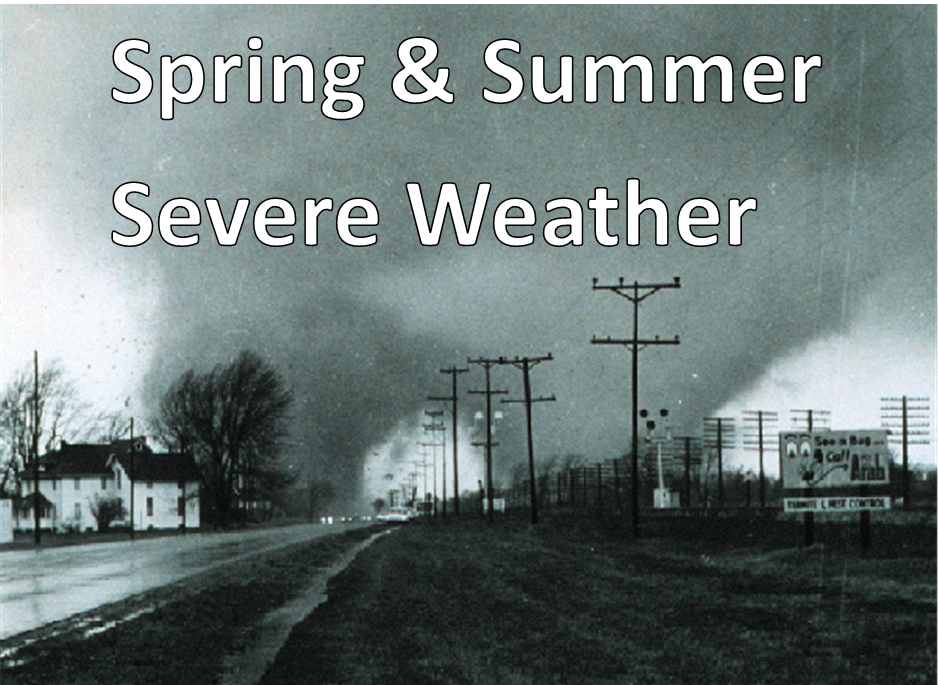CLICK HERE or the image above to access INPREPared's collection of educational resources about severe spring and summer weather conditions, including tornadoes, thunderstorms, and lighting. The "Spring & Summer Severe Weather" site contains a variety of educational materials for use by Extension, teachers, media, and the general public, including PREPnotes, PREPclip videos, archived news postings, links to ready-to-use social media, and more.
Thunderstorms Summary Info
All thunderstorms are dangerous. Every thunderstorm produces lightning. In the United States, an average of 300 people are injured and 80 people are killed each year by lightning. Although most lightning victims survive, people struck by lightning often report a variety of long-term, debilitating symptoms.
Most lightning victims are not struck during the worst of a thunderstorm but rather before or after the storm reaches its greatest intensity. This is because many people are unaware that lightning can strike as far as 25 miles away from its parent thunderstorm, much farther out from the area of rainfall within the storm!
Other associated dangers of thunderstorms include tornadoes, strong winds, hail, and flash flooding. Flash flooding is responsible for more fatalities—more than 140 annually—than any other thunderstorm-associated hazard.
Key Terms
- SEVERE THUNDERSTORM WATCH: Thunderstorms are likely to occur. Remain alert for approaching storms. Watch the sky and stay tuned to NOAA Weather Radio, commercial radio, or television for information.
- SEVERE THUNDERSTORM WARNING: A thunderstorm has been reported by spotters or indicated by radar. Warnings indicate imminent danger to life and property to those in the
path of the storm.
Before a Thunderstorm
To prepare for a thunderstorm, you should:
- Remove dead or rotting trees and branches that could fall and cause injury or damage during a severe thunderstorm.
- Remember the 30/30 lightning safety rule: Go indoors if, after seeing lightning, you cannot count to 30 before hearing thunder. Stay indoors for 30 minutes after hearing the last clap of thunder.
- Postpone outdoor activities.
- Get inside a home, building, or hard top automobile (not a convertible). Although you may be injured if lightning strikes your car, you are much safer inside a vehicle than outside.
- Remember, rubber-soled shoes and rubber tires provide NO protection from lightning. However, the steel frame of a hard-topped vehicle provides increased protection if you are not touching metal.
- Secure outdoor objects that could blow away or cause damage.
- Shutter windows and secure outside doors. If shutters are not available, close window blinds, shades, or curtains.
- Avoid showering or bathing. Plumbing and bathroom fixtures can conduct electricity.
- Use a corded telephone only for emergencies. Cordless and cellular telephones are safe to use.
- Unplug appliances and other electrical items such as computers and turn off air conditioners. Power surges from lightning can cause serious damage.
- Use your battery-operated NOAA Weather Radio for updates from local officials.
During a Thunderstorm
If you are:
- In a forest
- In an open area
- On open water
- Anywhere you feel your hair stand on end (which indicates that lighting is about to strike)
Then you should:
- Seek shelter in a low area under a thick growth of small trees
- Go to a low place such as a ravine or valley. Be alert for flash floods.
- Get to land and find shelter immediately.
- Squat low to the ground on the balls of your feet. Place your hands over your ears and your head between your knees. Make yourself the smallest target possible to minimize your contact with the ground. DO NOT lie flat on the ground!
Following a Thunderstorm
The following are guidelines for the period following a flood:
- Check for injuries. Do not attempt to move seriously injured persons unless they are in immediate danger of death or further injury. If you must move an unconscious person, first stabilize the neck and back, then call for help immediately.
- If you are trapped, cover your mouth with a cloth or mask to avoid breathing dust. Try to call, send text message, bang on pipe or wall, whistle, or shout.
- Be aware of exhaustion. Don’t try to do too much at once. Set priorities and pace yourself. Get enough rest.
- Drink plenty of clean water.
- Eat well.
- Wear sturdy work boots and gloves.
- Wash your hands thoroughly with soap and clean water often when working in debris.
Additional Resources
If you need more information contact: inprepared@purdue.edu.
© 2025 Purdue University | An equal access, equal opportunity university
615 West State Street, West Lafayette, IN 47907-2053
If you have trouble accessing this page because of a disability, please email us at inprepared@purdue.edu.



